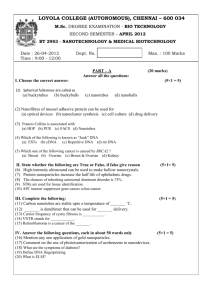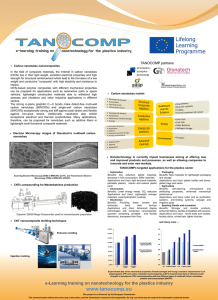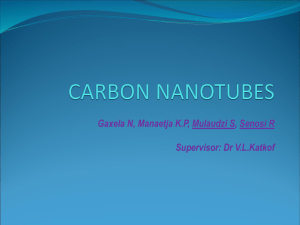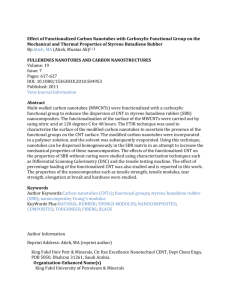Transport Properties of Carbon Nanotubes
advertisement
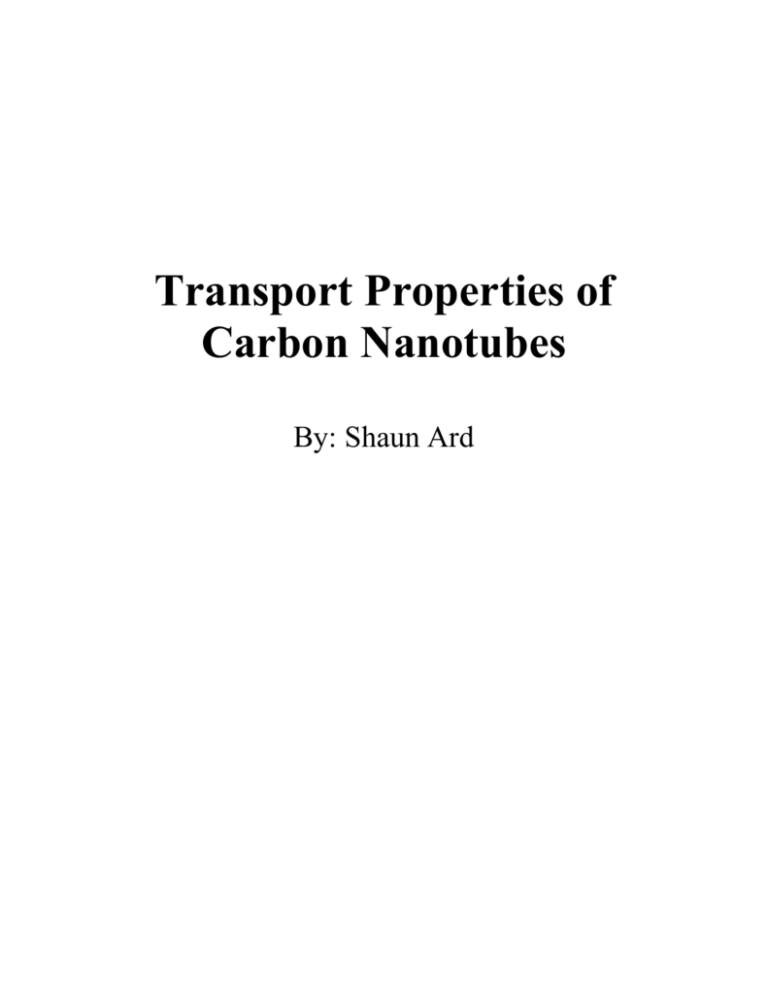
Transport Properties of Carbon Nanotubes By: Shaun Ard Carbon nanotubes are on the forefront of a multitude of exciting research areas. They offer research opportunities to both the application focused engineer and the fundamental theorist alike. Of particular interest to this diverse field is the area of transport through these nanotubes. The unique characteristics of the nanotubes allow for potential applications into nano-based electronics, as well as offer a simple onedimensional system for the study of fundamental quantum models. The transport properties of carbon nanotubes are very much dependant on the exact nature in which it is formed. Therefore, one must start with a proper basis with which to describe them. It can be defined by a graphene sheet and its familiar hexagonal unit cell. Two unit vectors â1 and â2 are used to form the chiral vector, Ch = n â1 + m â2, which describes how the graphene sheet is “rolled up” to form the nanotubes illustrated in Figure 11. This chiral vector, or the associated (n,m) index, is used to describe the type of nanotubes. The important measurables such as helicity and circumference can be expressed in terms of these indices. Figure 1. Schematic representation showing the formation of the nanotubes from a graphene sheet (a). Tubes are classified as armchair (Ba), zigzag (Bb), or chiral (Bc) based on their (n,m) index (Popov). One of the more interesting transport properties of nanotubes is the demonstration of both semi-conducting and metallic properties. This can be explained with a fairly simple model; since nanotubes are essentially just "rolled up" graphene sheets, then that is how they are described theoretically. One starts with the 2 dimensional band structure of graphene, which is well described by a tight binding model. The band structure of the nanotubes is then derived from "folding" this band structure in a way based on the chirality and therefore the (n, m) index of the nanotubes, as seen in Figure 2. This model predicts nanotubes to behave metallically if n-m is evenly divisible by 3, and semiconducting with a finite band gap otherwise. Work done by Odom et al.2 utilized scanning tunneling microscopy (STM) to probe both the structure and electronic density of states simultaneously. They found that different nanotubes clearly behaved as either metals or semiconductors, seemingly in agreement with the predictions based on their indices. Advances in growth techniques have allowed for connection of nanotubes to electrodes for detailed transport study. Semi-conducting tubes have been looked at in this regard for applications in Field Effect Transistors (FETs). For conducting tubes, however, this has allowed for study fascinating aspects of low dimensional quantum effects. Bockrath et al., studied the transport across ropes of single walled nanotubes (SWNTs) 3,4. Figure 2 shows the I-V measurements of these ropes for a variety of temperatures. They found significant suppression of the conductance near V=0 for low temperatures. In addition, the conductance at low temperature (1.3 K) consisted of a series of sharp peaks that broadened at higher temperatures, when plotted versus gate voltage as seen in Figure 2. This is due to the electron-electron interaction playing more of a role in this system. The contacts essentially form a zero dimensional quantum dot out of the nanotubes, with the electron described well as a particle in a box. These quantized levels combined with the electron interaction are described as a Coulomb Blockade, that is prevalent at the low temperatures. The periodicity of the peaks imply that transport through these ropes is dominated by a single metallic tubes, consistent with the (n,m) index prediction that most of the tubes would be semi-conductors and thus nonconducting at these temperatures. Figure 2. I-V plot for different temperatures (left). Conductance versus gate voltage (a) with peaks evident of Coulomb Blockade. Temperature broadening of these peaks (b) (Bockrath). The continued work on this subject by Brockath et al highlights the importance of interactions between electrons in this system. This marks the deviation from the Fermiliquid model typically applied to conductors, to that of a Luttinger-liquid (LL) where even small Coulomb interactions have a significant impact. In Figure 3, we again see a plot of conductance versus gate voltage, this time for several temperatures. At low T, we again see evidence of the Coulomb Blockade, which is then "washed out" as T is increased. However, this model alone doesn't explain the strong dependence of conductance on T. Whereas the tunneling amplitude into a Fermi-liquid is expected to be energy independent, the electron correlation in a LL is expected to vanish as a power law with respect to energy. This then implies a power law dependence of conductance on T at low bias, and the bias itself at higher voltages. The inset in Figure 3 shows this power law dependence on T. Figure 3. Conductance versus gate voltage for noted temperatures. Temperature dependence of conductance (inset) (Bockrath). Further evidence of LL behavior in this system is seen in the differential conductance behavior with respect to bias voltage. Figure 4 shows this relationship for different temperatures and is scaled to include them on the same plot. The relationship is that of a power law at higher bias voltages as predicted for a LL. Additionally, Figure 4 highlights the two different methods of connecting the nanotubes to the electrodes for these experiments, end and bulk contacted. For this system the contact interface is crucial and the difference between the contact types is evident in the power law scaling factors. However, this remains an area for further study to better understand. Figure 4. Scaled differential conductance versus bias voltage for both bulk contacted (a) and end contacted (b) (Bockrath). Other fundamental phenomena are evident in nanotube transport. Babic and Schönenberger5 did work similar to that previously mentioned. However, they were able to create very "transparent" connections to the nanotubes with which they could then control by varying the gate voltage. The differential voltage was then plotted with respect to both bias and gate voltages. Figure 5 shows this plot and the interesting physics involved. At high gate voltages there is weak coupling between the nanotubes and the contacts forming a quantum dot evidenced by the coulomb blockade features discussed earlier. As the gate voltage is lowered, the contacts become more transparent and the coupling becomes intermediate. Higher order tunneling terms come in to play forming Kondo resonances. As the gate voltage is minimized and the coupling maximized, the quantum dot approaches an open wire. The conductance approaches the theoretical maximum for a single tube, 4e2/h. However, residual scattering from the contacts results in the remaining periodicity. Interestingly, sharp resonances arrise that are well modeled as Fano resonances. The source of the resonant and non-resonant channels contributing to this Fano resonance are still not well understood. This experiment provides an example of the different quantum regimes available for study with carbon nanotubes. Figure 5. Differential conductance versus bias (Vsd) and gate (Vg) voltages, with the corresponding linear response conductance underneath (Babic). Whereas the previously discussed experiments focused on dc electrical transport, Zhao et al6, looked into frequency dependant transport. Figure 6 shows the multiple probe set up employed as well as the impedance versus frequency plots measured. They found that the impedance could be modeled fairly well as an RC circuit with one major discrepancy; there is a very sharp resonance at 37.6 kHz consistently appearing. Figure 7 shows this resonance remaining for tubes of different lengths. This along with temperature dependant data leads the authors to believe it is an intrinsic feature to the nanotubes, but is not well understood beyond that. Figure 6. Real and imaginary parts of the impedance (dotted) versus frequency for both high (a,b)and low(c,d) frequency regimes. Additionally, theoretical values (solid) using a R-C circuit model. Multi-probe setup employed for multiple lengths of tube (e) (Bockrath). Figure 7. Differential impedances for varying tube lengths showing the consistency of the resonance. The experiments referenced above are but a sampling of the considerable research involving transport in carbon nanotubes. Potential application aside, these nanotubes offer insight into an array of exotic phenomenon. It offers opportunity to both tune current models and develop new ones. As preparation methods and experimental techniques evolve our understanding of the most fundamental aspects of physics shall only improve. 1 V. Popov, Carbon nanotubes: properties and applications, Materials Science and Engineering R 43 (2004) 61-102 2 T.W. Odom, J. Huang, P. Kim, C. Lieber, Atomic Structure and Electronic Properties of Single-Walled Nanotubes, Nature (London) 391 (1998) 62 3 M. Bockrath, D. Cobden, P. McEuen, N. Chopra, A. Zettl, A. Thess, R. E. Smalley, Single-Electron Transport in Ropes of Carbon Nanotubes , Science 275 (1997) 1922 4 M. Bockrath, D. Cobden, Jia Lu, A. Rinzler, R. Smalley, L. Balents, P. McEuen, Luttinger-liquid behaviour in carbon nanotubes, Nature 397 (1999) 598 5 B. Babic and C. Schönenberger, Observation of Fano resonances in single-wall carbon nanotubes, Phys. Rev. B 70 (2004) 195408 6 Y. Zhao, B. Wei, P. Ajayan, G. Ramanath, T. Lu, G. Wang, A. Rubio, S. Roche, Frequency-dependent electrical transport in carbon nanotubes, Phys. Rev. B 64 (2001) 201402-1

